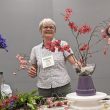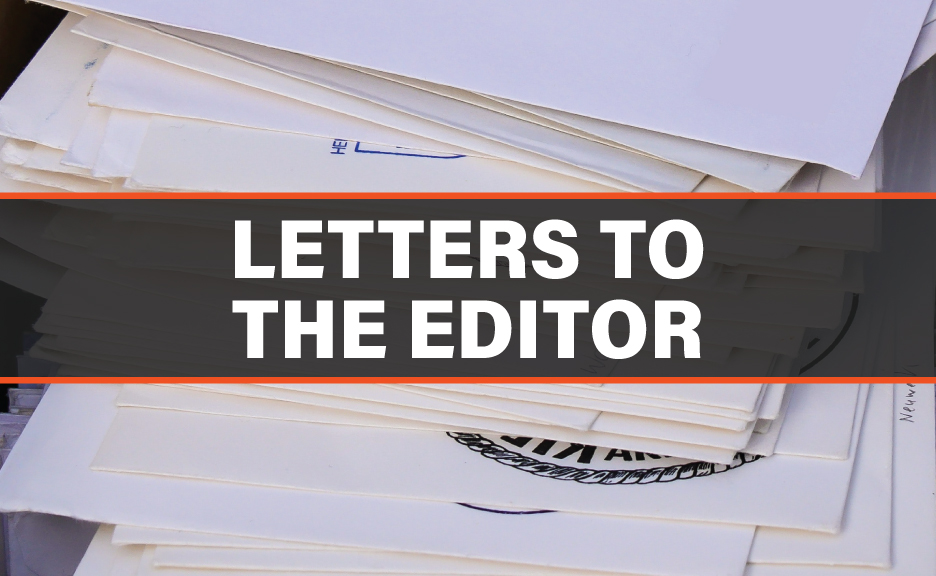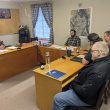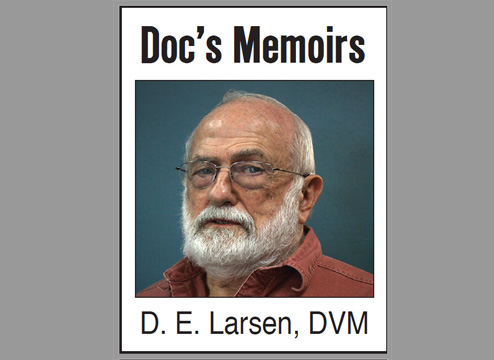Hardware disease, which results from a cow’s indiscriminate eating habits, was frequently seen when hay was baled with wire.
Any stray sharp metal, like a nail, could be involved. The hardware would fall into the reticulum, which is considered the second stomach. The cow’s heart lies just on the other side of the diaphragm from the reticulum. Then, when the wire pierced the reticulum and the diaphragm, it would poke into the heart. This can cause acute discomfort and, rarely, rapid death. It’s more like a slow death from an infection around the heart and chronic heart failure.
My first recollection of a cow with hardware was with our Linda cow at Broadbent. Named after my sister, Linda was a Jersey cross. She was the least attractive of all of our cows. Probably crossed with a Guernsey, she was white with some orangish brindle coloration.
In the early 1950s, hardware disease was treated with surgery. The rumen was opened on the left side. The operator would remove some of the content and then reach anteriorly to the reticulum and extract the offending wire.
Dr. Crawford, a veterinarian from Coquille, did Linda’s surgery. She carried an ugly scar for the rest of her life, which was not unusual after that procedure.
By the 1960s, hardware disease was treated with a magnet given orally to the cow. It would fall into the reticulum, secure the offending hardware and withdraw it into the stomach through regular stomach activity. It would stay with the magnet until it rusted away.
One valuable cow was treated at Colorado State University Veterinary Hospital while I was in school. The animal was suffering severe pericarditis (infection around the heart) from hardware disease. In a last-ditch effort to save the cow, one rib section was removed and the pericardium was opened to the outside. This area could be flushed a few times a day. However, there was a large amount of inflammatory tissue in the pericardium, constricted as it aged, and the treatment failed.
My first case of hardware disease after graduation occurred in Enumclaw. Andy had called with a steer that was not doing well.
“I don’t know what is going on with him, Doc,” Andy said. “He just stands mostly and walks sort of stiff-legged when he does move.”
Andy had the animal in his old dairy barn, just loose in the stanchion area.
“Let me get my rope, and we will get a look at him,” I said.
When the lasso landed over his head on the first throw, it surprised both the steer and me. He jumped to the right, then back to the left and fell over dead.
“What the heck happened to him?” Andy asked in amazement.
A quick necropsy showed a five-inch wire poking into his heart. Had I been able to restrain him quickly, a magnet possibly could have saved him.
“My guess is you are feeding hay baled with wire,” I replied.
“Yes, I just got a new load of alfalfa,” Andy said.
“I would suggest you give all your other cows a magnet,” I explained. “It is pretty easy to do, and it is a good preventative for this type of thing. Although it is rare to see a steer drop dead like this one.”
“So, was that in the hay, or did I do that when I opened the bale?” Andy asked.
“There is no answer to that question,” I said. “I guess it doesn’t matter to this guy.”
“Can we eat him?” Andy wondered.
“I guess that depends on how hungry you are,” I said. “He doesn’t qualify, according to the food inspection criteria. He probably had a temperature and some inflammation. Obviously, you could eat him, but I don’t think the meat will be very good.”
***
Barney Kolousek was my very first call in Sweet Home. I’d only been in town for a couple of days when the phone rang.
“Doc, this is Barney Kolousek. Stan Ego over at the feed store told me you were in town. I have a cow that stopped eating a couple of days ago, and she is just not doing very well. I sure would like for you to get a look at her.”
“Barney, I am really not ready to do any calls,” I said. “I don’t have most of my equipment and drugs yet.”
“If you could just look at her,” Barney countered. “If I have to call Albany, it will take them three days to get out here. It is going to be great, having you in town.”
“OK,” I said. “I will get a look at her, but no promises.”
Barney’s place was up Ames Creek. He had several acres and a couple of cows. I pulled into the driveway in our car, as I didn’t yet have a truck. Barney was waiting.
“Hi, I am Barney,” he said, shaking my hand. “I hated to pressure you, Doc, but you have to realize how difficult it has been to get a veterinarian out here in the past. Everybody is excited that you are coming to town.”
“I’m glad to meet you, Barney,” I said. “I’m here. It’s just that I’m not quite organized yet. Shipments of equipment and supplies are coming every day, but the clinic is way behind schedule. The little two-bedroom apartment we have rented is bursting at the seams. We have boxes stacked to the ceiling. But let’s get a look at this cow of yours. Oh, by the way, Barney, you are my very first client in Sweet Home.”
His cow, Rosebud, was a Hereford. She was in good shape – probably a little overfed, in fact. I would guess she was five or six years old. An exam showed a slightly elevated temperature and much reduced rumen motility. Everything else was within normal limits.
“How long has she been sick, Barney?” I asked.
“I noticed that she stopped eating a couple of days ago,” he replied. “She has just been standing around, not moving much.”
I squatted beside Rosebud on her left side, then leaned against her belly with my elbows on my knees and placed both fists in the center of her stomach, close to the edge of her ribs. Then, with a hard push upward, like a punch in the gut, I jiggled her entire abdomen. Rosebud let out a noticeable groan, almost a diagnostic pain response for hardware disease.
“She has a wire, Barney,” I said.
“A wire?” Barney repeated. “What are you talking about?”
“Cows aren’t very discriminating when they are chewing on hay,” I explained. “If there is a wire in that hay, it goes right on down. It falls into the reticulum, a little pouch on the front of the rumen. If the wire happens to puncture the wall, it is a very short distance to the heart.”
“So, what do we do about it?” Barney asked. “It seems I have heard about them doing surgery because of a wire.”
“At this stage in the game, we rarely have to do surgery,” I said. “I will give her a magnet and some long-acting sulfa boluses. I just happen to have both of those. That should take care of things in a day or two.”
“That sounds better than surgery,” Barney said. “Do I have to do anything with her?”
“You just keep an eye on her,” I said. “Call if she is worse tomorrow. I will give you a call or probably just drop by when you get off work in a couple of days. Since you are my first call, I don’t have a lot to do just yet. I should have plenty of time to look after her.”
* * * * *
Two days later, when I stopped at Barney’s, Rosebud was out in the pasture, grazing. Barney came out of the house, all smiles.
“Doc, Rosebud is acting like nothing was ever wrong with her,” he said. “I can’t thank you enough, and I am so glad that you came to town. We will see you again, I’m sure.”
“Thanks, Barney,” I said. “Just give me a call when you need me.”
– David Larsen is a retired veterinarian who practiced 40 years in Sweet Home. More of his stories are available on his blog at docsmemoirs.com.





